What You Need
You need a Linux machine. I used BackTrack 5 R1.Starting the Linux Machine
Start your machine as usual. Open a Terminal window. In a Terminal window, enter this command, and then press Enter:
ping samsclass.info
Make sure you are getting replies.
If you are not, you need to correct
your networking problems before
proceeding.
Generating a Server Key
In a Terminal window, enter these commands, pressing Enter after each one:When you see the message: "Enter pass phrase for server.key:" type a passphrase. For this project I recommend using a phrase of password -- use a more secure password on a real production server, of course.apt-get install openssl mkdir /cert
cd /certopenssl genrsa -des3 -out server.key 4096
When you are prompted to enter the passphrase a second time, do so. You won't see anything on the screen when typing in the passphrases, which is normal for Linux.
Create a Certificate Signing Request
In a Terminal window, enter this command, and then press Enter:
openssl req -new -key server.key -out server.csr
Enter a passphrase of password
Enter a Country Name of US
Enter a State or Province Name of CA
Enter a Locality Name of San Francisco
Enter an Organization Name of YOUR NAME -- don't enter the literal words "YOUR NAME" -- use your own first and last name.
Leave the Orgizational Unit Name blank, by pressing Enter.
Enter an Common Name of YOUR NAME -- don't enter the literal words "YOUR NAME" -- use your own first and last name.
Leave the Email Address blank, by pressing Enter.
Leave the Challenge Password blank, by pressing Enter.
Leave the "optional company name" blank, by pressing Enter.
Sign the Certificate Signing Request
In a Terminal window, enter this command, and then press Enter:
openssl x509 -req -days 365 -in server.csr -signkey server.key -out server.crt
When it prompts you for the passphrase, type
password
Make a Version of the Server Key that Doesn't Require a Password
In a Terminal window, enter these commands, pressing Enter after each one. When it prompts you for the passphrase, type passwordopenssl rsa -in server.key -out server.key.insecure mv server.key server.key.securemv server.key.insecure server.key
The Four Files
In a Terminal window, enter this command, and then press Enter:
ls
Note that the first character is a lowercase
L, not the numeral 1.
You should see these four files:
server.crt: The self-signed server certificate.
server.csr: Server certificate signing request.
server.key: The private server key, does not require a password when starting Apache.
server.key.secure: The private server key, it does require a password when starting Apache.
Configuring Apache for SSL
In a Terminal window, enter these commands, pressing Enter after each one. When it prompts you for the passphrase, type passwordmkdir /etc/apache2/ssl cd /cert
cp server.key /etc/apache2/ssl
cp server.crt /etc/apache2/ssl
a2enmod sslln -s /etc/apache2/sites-available/default-ssl /etc/apache2/sites-enabled/000-default-ssl
Creating the Secure Document Root
These commands create a directory /var/www-ssl, which is the home for your secure Web pages. In a Terminal window, enter these commands, pressing Enter after each one.cd /varmkdir www-ssl
Back Up Apache Configuration Files
In a Terminal window, enter these commands, pressing Enter after each one.cd /etc/apache2/sites-available
cp /etc/apache2/sites-available/default default_originalcp /etc/apache2/sites-available/default-ssl default-ssl_original
Configuring Virtual Hosts
In a Terminal window, enter this command, and then press Enter:
ifconfig
Find your IP address and make a note of it.
Note: If your IP address changes, you will have to re-edit two files to continue this project. I therefore recommend using NAT networking in VMware so your IP address does not change as often.
In a Terminal window, enter this command, and then press Enter:
nano /etc/apache2/sites-available/default
In the text editor, add this line after the
<VirtualHost *:80> line,
using your correct IP address instead of
the example below:
ServerName 192.168.198.135:80
Your file should look like the image below:
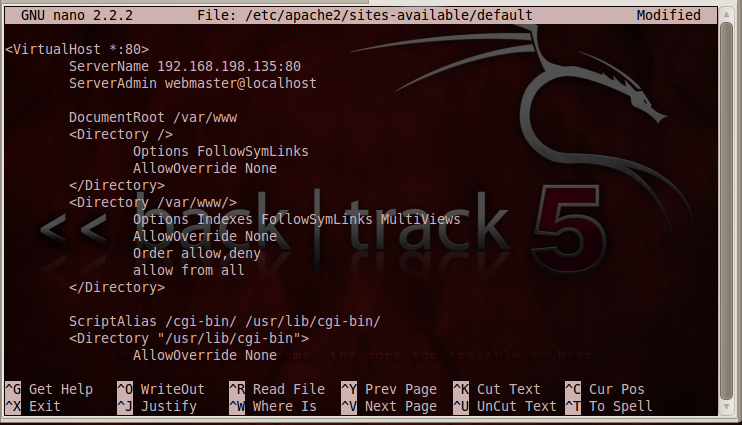
Press Ctrl+X, Y, Enter to save the file. In a Terminal window, enter this command, and then press Enter:
nano /etc/apache2/sites-available/default-ssl
In the text editor, add this line after the
<VirtualHost *:443> line,
using your correct IP address instead of
the example below:
ServerName 192.168.198.135:443
Change the line that reads:
DocumentRoot /var/www
to
DocumentRoot /var/www-ssl
Your file should look like the image below:
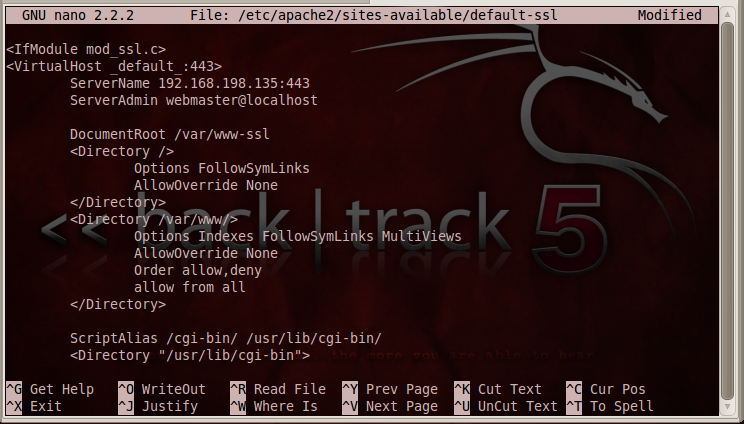
Scroll down and find these two lines:
SSLCertificateFile /etc/ssl/certs/ssl-cert-snakeoil.pem
SSLCertificateKeyFile /etc/ssl/private/ssl-cert-snakeoil.key
Change them to this:
SSLCertificateFile /etc/apache2/ssl/server.crt
SSLCertificateKeyFile /etc/apache2/ssl/server.key
Your file should look like the image below:
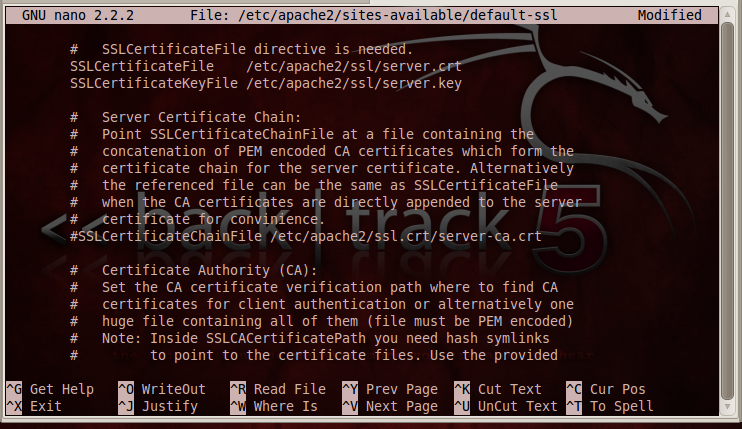
Press Ctrl+X, Y, Enter to save the file.
Making a Demonstration Web Page
In a Terminal window, enter this command, and then press Enter:
nano /var/www-ssl/index.html
In the text editor, enter this code,
replacing "YOUR NAME" with your own
name:
<html>
<body>
<h1>Test Page on My HTTPS Server</h1>
<h2>by YOUR NAME</h2>
</body>
</html>
Your file should look like the image below:
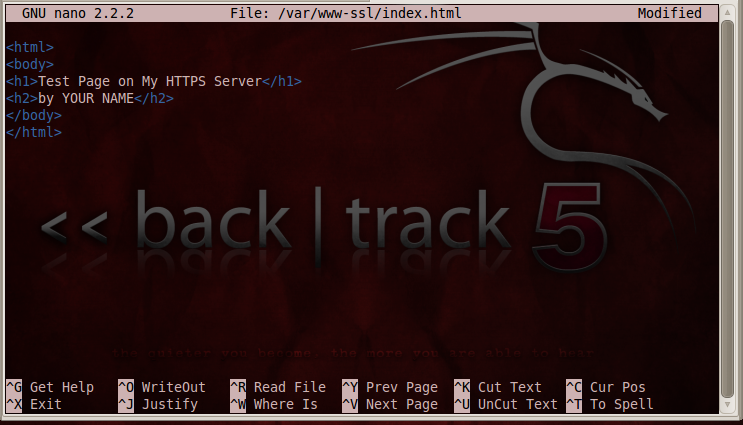
Press Ctrl+X, Y, Enter to save the file.
Restarting Apache
In a Terminal window, enter this command, and then press Enter:/etc/init.d/apache2 restart
Viewing the Secure Web Page
From the upper left of the Linux desktop, click Applications, Internet, Firefox Web Browser. Enter this URL, and then press Enter:https://localhost
A warning page appears, saying "This Connection is Untrusted". That's happening because your SSL certificate is self-signed, rather than purchased from a real Certificate Authority like Verisign.
Click "I Understand the Risks".
Click the "Add Exception" button.
Click the "Confirm Security Exception" button.
Your secure web page opens, as shown below:
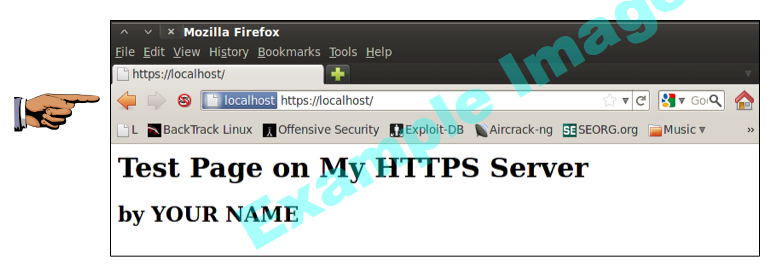
Press Ctrl+X, Y, Enter to save the file.
No comments:
Post a Comment